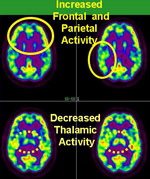Contribute
| Comparing The Neural Images Of Three Different Types Of Meditation |
Dr. Fred Travis
03/19/2008
About the Author: Fred Travis, Ph.D. is the Director of the Center for Brain, Consciousness, and Cognition, and an Associate Professor of Maharishi Vedic Science at Maharishi University of Management.
Let us compare three forms of meditation. Scientific research on the
functioning of the brains of practitioners of these techniques have
been published in peer-reviewed journals. The three forms in this
document are: Mindfulness Meditation (also called Insight Meditation or
Vipassana), Tibetan Buddhist Tsonghakapa, and the Transcendental Meditation®
technique from the ancient Vedic tradition of India. These three
methods have different procedures, different neural images (pictures of
the brain or brain functioning), and different EEG patterns (electrical
activity of the brain). Type of Meditation Procedure Insight, Vipassana, Mindfulness Observation [Reference 1] Tibetan Buddhism Concentration [2] Transcendental Meditation Technique Effortless Transcending [3] The neural images of different types of meditation
are distinctly different. Brain blood flow and brain metabolic rate can
be imaged with modern neural imaging techniques using MRI (Magnetic
Resonance Imaging) or PET (Positron Emission Tomography). These data
are from independent labs reports and published research. Type of Meditation: Mindfulness Type of Meditation: Tibetan Buddhism Type of Meditation: Transcendental Meditation Technique The curious reader is invited to read the complete presentation
that I gave at the Science of Consciousness conference in Tucson, AZ,
April 2006. The complete slideshow also explains in more detail how
these three types of meditation compare in terms of brain metabolic
rate, and in EEG patterns. Meditations differ in procedure, in patterns of
brain blood flow, brain metabolic rate and EEG patterns. They also
differ in reported benefits. One cannot generalize the effects and
benefits of one meditation to all meditations.
End Notes 1. Meditation in the
Tibetan Buddhism Kargyu tradition has been described as: "Reasoned
deconstruction of the reality of objects experienced in meditation, as
well as concentrative practices to create moods such as "pure
compassion," "loving kindness" or "no self." This involves focused
attention, and control of the mind. It is a system of concentration.
There are many systems of meditation that widely
differ from one another in their procedures, contents, objects,
beliefs, and goals. Given these differences, it is not surprising that
research has shown they have different subjective and objective
effects. Scientific research on one type of meditation cannot be
generalized to effects from any type of meditation.
Different Neural Images
Neural Images: Thicker right insula, thicker right frontal,
thicker sensory [4]
Explanation: Higher gray matter volume—more
connections—are reported in areas used in focusing of attention (right
frontal areas) and brain areas involved with sensory perception: the
right insula (taste and emotionally relevant context), right parietal
(touch) and right temporal (hearing). Thicker cortex suggests these
local areas are used during Mindfulness.
Neural Images: Activity in the frontal (left) increases; activity in the thalamus increases; activity in the parietal lobe decreases. [5]
Explanation: In Tibetan Buddhist Tsonghakapa
meditation, activity in the frontal lobe increases—this is what happens
when focusing. Activity increases in the thalamus, the gateway of
activation to the brain. Activity decreases in the parietal lobe (the
area of visual attention, spatial orientation, and cross-modal matching)
Neural Images: Activity in the frontal (left) increases; activity in the thalamus decreases; activity in the parietal lobe increases. [6]
Explanation: During the practice of the Transcendental
Meditation technique, frontal lobe activity increases, and so does the
parietal lobe. But the thalamus (the gateway of activation to the
brain) is less active. This is called restful alertness—pure
wakefulness: heightened alertness in the midst of deep silence for mind
and body.Conclusion
2. Mindfulness Meditation is described by Paul
Grossman as "Systematic procedure to develop enhanced awareness of
moment-to-moment experiences." Mindfulness includes two meditation
practices: with eyes closed: attention on breath, and with eyes open:
"dispassionate observation of body, senses and environment." This
meditation involves intention or directing of attention to
physiological rhythms, inner thoughts, sensations or outer objects.
3. EEG (electroencephalogram) tests show that TM is
effortless because it is quickly mastered (there is no difference
during the practice of TM in the EEG of someone who has been practicing
regularly for 10 years versus someone who has been practicing regularly
for 4 months). However, the waking state EEG of these subjects are
distinctly different (the more months or years the subject has been
practicing the TM technique, the more coherent their EEG pattern while
resting with their eyes open).
4.
Lazar, S. W., Kerr, C. E., Wasserman, R. H., Gray, J. R., Greve, D.
N., Treadway, M. T., McGarvey, M., Quinn, B. T., Dusek, J. A., Benson,
H., Rauch, S. L., Moore, C. I. & Fischl, B. (2005). Meditation
experience is associated with increased cortical thickness.
Neuroreport, 16, 1893-7.
5. Newberg, A., Alavi, A., Baime, M., Pourdehnad,
M., Santanna, J. & d'Aquili, E. (2001). The measurement of regional
cerebral blood flow during the complex cognitive task of meditation: a
preliminary SPECT study. Psychiatry Research, 106, 113-22.
6. Newberg, A., Travis, F., Wintering, N., Nidich,
S., Alavi, A. & Schneider, R. (2006). Cerebral Glucose Metabolic
Changes Associated with Transcendental Meditation Practice. Spring
meeting, Neural Imaging, Miami, Fl.
You may also access this article through our web-site http://www.lokvani.com/

SPECT images during Tibetan Buddhist Meditation show that the meditator is focusing and concentrating.

When practicing the Transcendental Meditation, the meditators thalamus (gateway of activation to the brain) is less active, creating "restful alertness": heightened alertness in the midst of deep silence for mind and body.

Author Fred Travis, Ph.D. is the Director of the Center for Brain, Consciousness, and Cognition, and an Associate Professor of Maharishi Vedic Science at Maharishi University of Management.